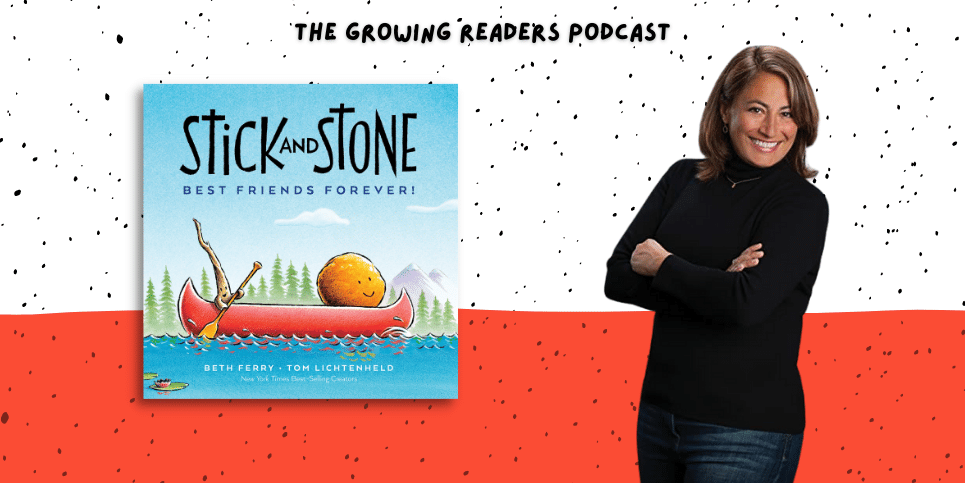An interview with Beth Ferry
The Children’s Book Review
In this episode, I talk with Beth Ferry, the author of several picture books, including the NYT-bestselling picture book Stick and Stone (2015), illustrated by Tom Lichtenheld.
Beth says: Words, to me, are like bees and butterflies, buzzing and fluttering inside my head, sparking my imagination. Today we’re going to talk about her latest collaboration with the very talented Tom Lichtenheld, STICK AND STONE: Best Friends Forever! It’s a story that demonstrates how our friends can truly become family.
Listen to the Interview
Read the Interview
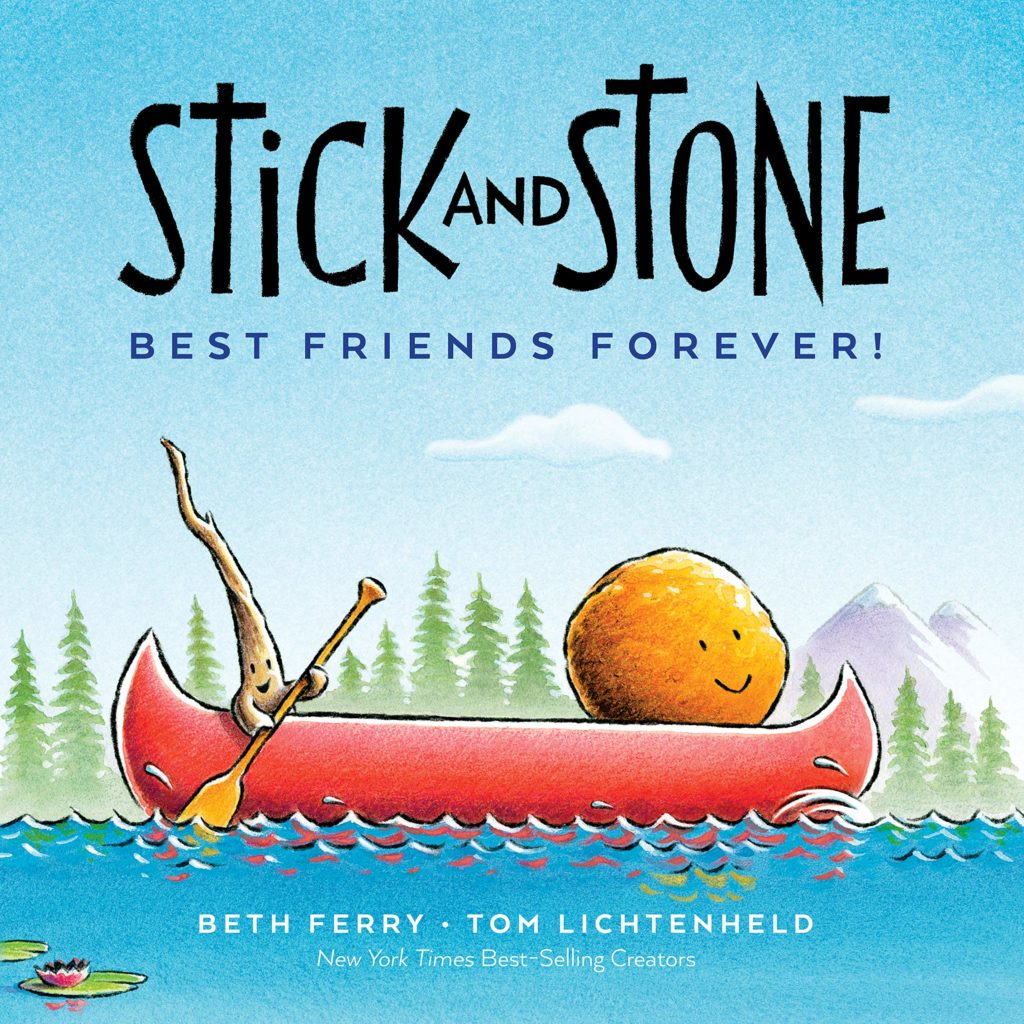
Bianca Schulze: Well, we have reviewed and featured a few of your books on The Children’s Book Review. And so, I’m really, really excited to talk to you about your newest book, Stick and Stone: Best Friends Forever, which is the follow up to your New York Times bestselling book, Stick in Stone, which came out in 2015. And you’re so lucky you have the wonderful illustrator, Tom Lichtenheld, too. So being a bestseller and all we know, there are many, many readers who will be so happy to see these characters again in this new story. But just in case any listeners may be unfamiliar with Stick and Stone, will you give everyone a little recap of that first book?
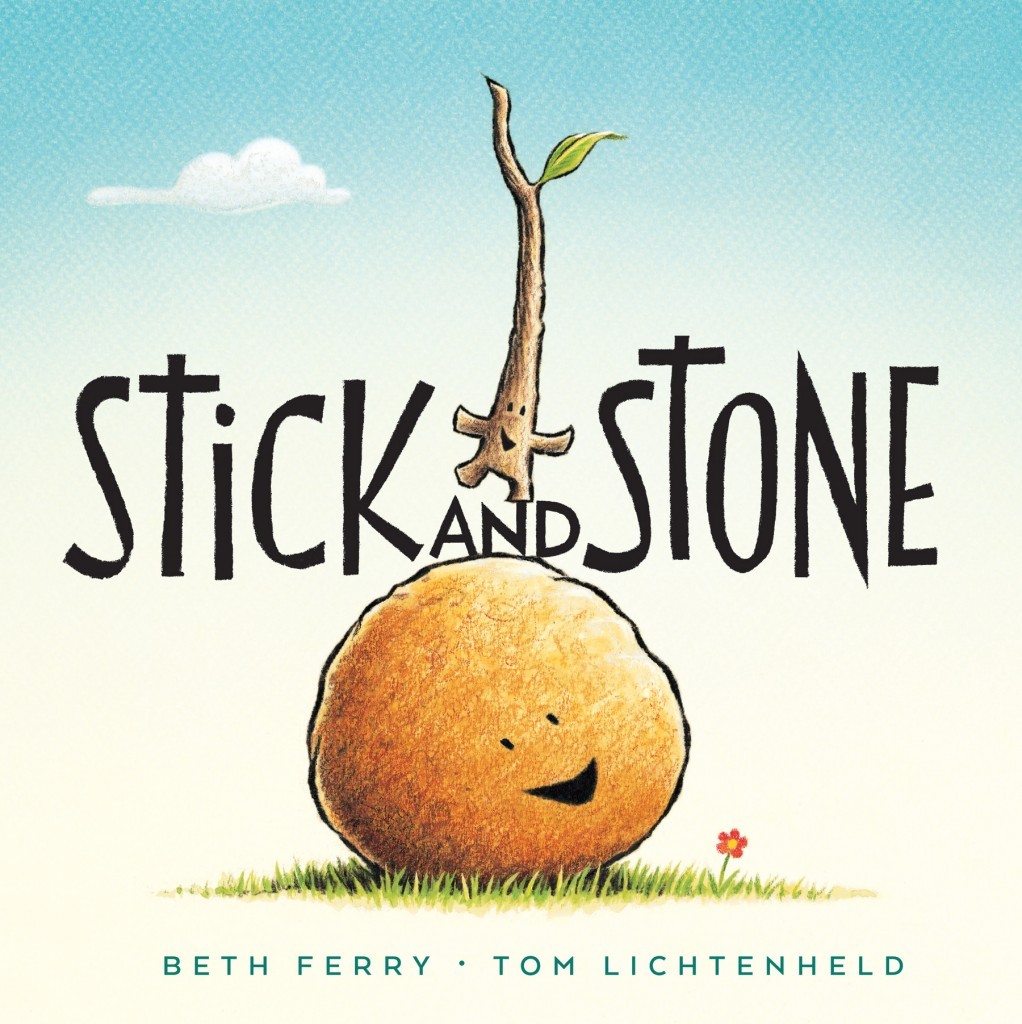
Beth Ferry: Sure. So, yes, Stick and Stone. I can’t believe it’s been six years now. Honestly, the time goes so fast. But it was my very first book and I had written it basically trying to get published, you know, as all aspiring writers are trying to be published. And I got the idea just from a song on the radio where there is a line about your best friend sticking up for you. And when I heard that line on the radio, I was like, oh, you know, that’s a really good idea about how hard it is to stick up for your friends. Like, you know, it’s easy to be a friend. But, you know, then to stick up for your friend in front of others isn’t so easy. So, the whole idea originated from the word stick and a stick sticking up for a friend, and then the whole sticks and stones, you know, break your bone—that old nursery rhyme. Basically, it is a book about friendship. It’s a book about how someone’s brave enough to stick up for someone. And that kind of cements the friendship. And then they have a few adventures, which, as we all know, doing things together is how friendship is formed. You know, it’s not some complicated formula. It’s just, you know, going to school, going to the playground, spending time together. So, the whole book was really, I think, about the bravery of being able to stick up for a friend and then just how friendships formed just by having adventures together.
Bianca Schulze: Well, it’s beautiful. And I love that first story. So now, these beloved buddies are embarking on a new adventure to find Stick’s family tree. When we think of the family tree, we think of all the branches connecting us with our family members. But for Stick, that’s part of it. But he’s looking for the literal tree that he came from. Tell us about this new book.
Beth Ferry: Right. So, I think what’s really interesting about this book is really the way that it came about. So, when I had originally written Stick and Stone, I had written a number of adventures for these characters. And, you know, they were going just to go and do a lot of different things. And as the years went by, Tom Lichtenheld will tell you he is not a big fan of sequels. So, a sequel really wasn’t in the books, so to say. So, a few years later, I decided that I would take all these original picture book stories and try to put them into a graphic novel series because, as I’m sure you know, graphic novels are like exploding and there are so many of them. And I had talked to Tom about it, and, you know, he thought it was a great idea. And so, I did. I wrote all these graphic novel stories. And when we approached our editor, she asked us if there was a sequel, like a picture book sequel. And really, truly, I was like, now there isn’t. I’ve used up all the stories that I can think of in these graphic novels. I don’t have something I’m going to say is good enough because, as you know, sequels are often a disappointment.
I was so afraid to do a sequel, you know. So, at first, I said no. I said, oh, I just don’t have it in me. I don’t have a story for them. But then, as most things happen, I started to think about it, and I really did. I thought, oh, it’s been six years that these characters have been friends. And like so many of our friends in real life, your friends become your family. They just do. You know, there are the people that you call, like when my kids need a ride somewhere. We don’t always call family members. We call friends, but they really are your family. So, to make a long story short, I decided to pursue the found family idea that these friends have now matured and had a relationship for so long that now they’re kind of like family, but they don’t know it. So, the whole idea is Stick decides he has lost his leaf in the first book, and he wants to go find his family tree. And, of course, his friend accompanies him. So, they go on into the forest and it’s scary. And they go on adventures to find the tree.
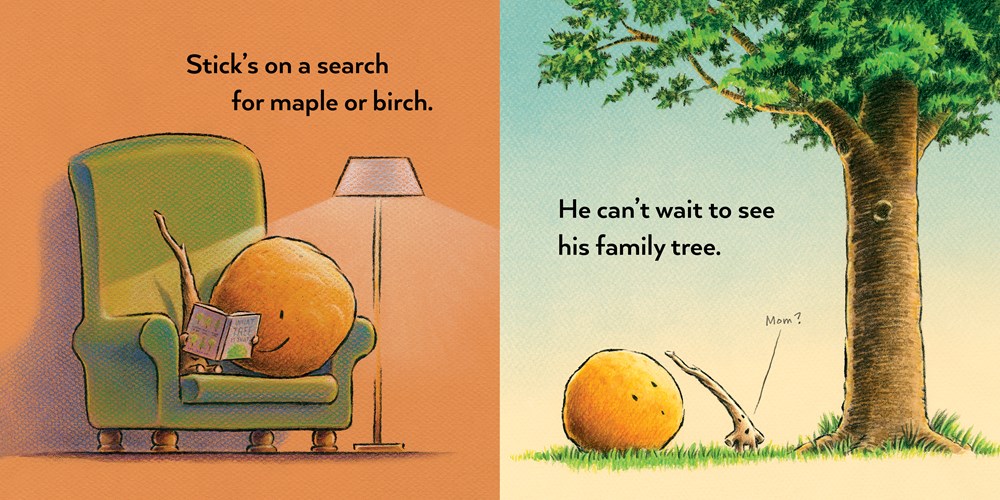
And what they find is each other—and don’t realize it at first. And then Stick realizes that not everyone has family that’s related to them, but they have people in their life that are their family. And it’s really satisfying. And the best part truly for me about this whole process was I had sent it to Tom, knowing full well he was not going to illustrate it—he has an assistant, Kristen Cella, and she’ll be doing the graphic novels—but fully aware that he would not be doing the story and that she would be doing it. And after he read it, he said. I want to do it. So that was like a big gift, so yeah, and then we worked at it together, which just was really fun because he would send me sketches and we would talk about it. And, you know, it was a true collaboration where the first book was not at all. I didn’t know him. We never spoke about it. And then this book was a complete collaboration with, you know, the text had been written, but we tweaked the text based on his art as you think a collaboration should be. So that was really special.
Bianca Schulze: Yeah, that is really special. Since we’re talking about Tom and his artwork, I just really love his ability to create facial expressions with a mere dot or a line, or maybe the mouth is in a line now, and then it’s a little triangle. Such simple changes in lines and shapes, and he pulls out these incredible, incredible expressions.
Beth Ferry: Yeah, I completely agree. I look at it and I think I should be able to do that. It’s just a dot and a line, but I can’t, of course. But yeah, I think that’s what I love about it most. Like I know for me when I’m looking at art, you know, especially children’s art, I always look at the eyes because eyes are so important. They’re like the most important part of the character. And yet, his eyes are truly just dots. And it doesn’t matter. They totally do exactly what eyes are supposed to do, which is convey emotion.
Bianca Schulze: Yeah, he’s so talented. Since we’re talking about the art, still. Can you share with me what your favorite illustration is from the book?
Beth Ferry: Yes. It’s funny how the art still can surprise you, even though you wrote the book—like Stick imagining himself as different types of trees, like maple, like oak, like pine. And for some reason, I just didn’t expect Tom to draw him with different kinds of leaves, which then turned into the endpapers, which is really Stick wearing all these different kinds of leaves. But in the book, there’s actually a page where he’s wearing three different types of leaves. And I just love it so much. I’m charmed by it. I love all their faces. But him wearing the different types of leaves just makes me happy.
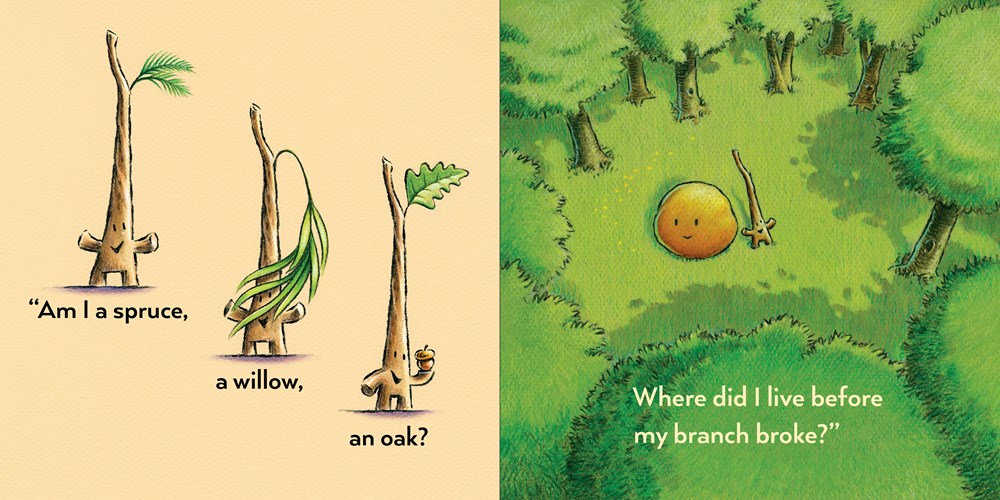
Bianca Schulze: The endpapers are outstanding. And I feel like that’s going to appeal to some sort of budding naturalist, too. You know, if they really pore over that and start exploring all the different trees out there. But I just love that it references that families are all different, too. And we all look different, and we all come in different shapes and sizes. And so, I think it’s really going to resonate with people this sort of storyline on that our friends truly are our family.
Beth Ferry: Yeah, I hope so, because I agree. And I think that this pandemic really has been when you couldn’t see your real family and you rely on your neighbors or on, you know, people within your sphere, which when you think about most of your friends are made in person. I mean, through the years, they might move and change. But, you know, you go to school, and you make them when you go to the park. And how do you make your friends by a personal interaction? I mean, we were all really limited this year with seeing our extended families if they didn’t live close. And, yeah, friends made all the difference.
Bianca Schulze: And I also think that sometimes our friends, that we’re more acquaintances with, in these sort of different times or in a time of need, we don’t realize how important some of our other friends are that maybe we haven’t been as close with before. And so, for me, when I was reading Stick and Stone: Best Friends Forever, I loved when Pinecone appeared. So Pinecone maybe wasn’t a favorite character from Stick and Stone. But in this book, Pinecone actually comes to the rescue. So, do you want to talk a little bit about Pinecone’s role?
Beth Ferry: It’s funny because I really wasn’t interested in introducing a new character. And I really felt like it’s one of my favorite things when I talk to kids when we get to the end of the original Stick and Stone. And I always ask the kids if Stick and Stone forgive him. So, you would be surprised by the answers, because, of course, I’m expecting everyone to say yes, of course, they forgive him. But it’s a really great conversation about forgiveness because it’s not easy to forgive someone if they’ve hurt your feelings. And I love that it’s not even part of the plot of the story. It’s just at the very end. But I think it’s a really important conversation, how hard it is to forgive someone, and how important it is.
I loved giving Pinecone the opportunity to come back and help them, even though they’re not great friends. You know, it’s not like, you know, the three of them went off. It’s still just Stick and Stone. But he’s in their world. And he is good, too. And I love that idea, too. That you can be bad or unkind, but then you can also redeem yourself. And I like the idea of redemption.
Bianca Schulze: I felt like that was such a great use of Pinecone and I’m so glad that you put Pinecone in, because obviously since Stick and Stone is a New York Times bestseller, there’s a lot of kids out there that have read Stick and Stone. And so, I think they’re going to feel that same way as I did when they read Best Friends Forever.
Beth Ferry: I hope so. Thanks.
Bianca Schulze: So, I know that words themselves, just words are really important to you. So, what would you say drives you and guides you in creating books? Is it your love of words?
Beth Ferry: I think, you know, it’s a complicated relationship between words and stories and then sharing it with children. You must write for yourself first. I truly believe that. You know, you can’t write something that is unnatural to you. So, you write what inspires you. And I know for me, it’s the words that always just start the idea. But then I find when I look at my bookshelf, I’m like, wow, I really write about friends and pets a lot. And so, I’m not consciously saying I’m going to write another book about friendship. And I find that I just always kind of do. I find that really interesting.
So, there are many reasons to write for kids, and there are many different writers. And I love that there are so many books because obviously there is a book for everyone. But for me, like I think when I talk to kids, I want to share my love of words because I think word … there are so many. And I think we don’t give them enough attention. And I always think if I can make a child enjoy a story and want to read. I think that the words kind of follow.
I’m sure most writers do this. You know, you’re reading a sentence, and you’re like, wow, that sentence. How is that sentence so perfect or beautiful, or evocative? And it’s just because the right words are strung together. You know, kids really enjoy reading. I don’t think kids enjoy writing so much. So, my idea is that if they can see how just putting a few words together in the right order, you know, it’s not that hard. And it can make them look at writing in a little bit of a different way, that it’s just words. You know, it’s not a big, complicated thing. It’s just finding the words that you like.
Bianca Schulze: Yeah. And so, this leads me to one of my favorite questions that I like to ask. They say to be a writer, you need to be a reader first. And so, I feel like that kind of goes hand in hand with what you’re saying. So, I know that you like to read every day and you actually shared a quote ahead of this chat. And I’m just going to read it here because I had never heard this quote before. And it felt like it was written for me.
Beth Ferry: Me, too.
Bianca Schulze: It says: I cannot remember the books I’ve read any more than the meals I have eaten. Even so, they have made me, me. And it was a quote by R.W. Emerson. And I really do believe that to be a writer, you need to be a reader first. I also feel like there’s a little bit of a sort of stigma that comes along with identifying yourself as a reader or even doing what I do. People assume that you’ve read every single book. And it’s just not possible for one person to read every book. But you need to read the books that are meaningful to you. That speaks to you. And I can’t always recall exactly what every single book I’ve read was about, but I can tell you how it made me feel. And that means it’s impacted me and sort of guided me onto who I’ve become. And I really believe that.
Beth ferry: Yeah, I think I think so, too. Like when I read that quote, I think you get asked a lot as a writer, you know, what’s your favorite book? What book inspired you? And I really couldn’t answer it because honestly, some weeks it’s fiction, some weeks it’s nonfiction, some weeks it’s an adult book, and some weeks it’s a kid’s book. And so, when I saw that quote, I was like, ok, yes, yes. A thousand times. Yes. Like they have made you—from the books that you can’t even remember reading as a child.
I couldn’t tell you what I read when I was 10. I don’t know. There were so many less books for children, first of all. But they all have, you know, made me into the person that I am today. And I like to read everything. I mean, when I was young, I always finished a book no matter what. If I started a book, I finished it. But now, I don’t feel that way. Now I feel like if it doesn’t click with me, I’m going to read something else because there are so many great books out there. I say to kids all the time: if you’re not a reader, the chances are you’re not going to become a writer, which could totally be wrong. But that’s my feeling. Why would you want to write if you didn’t love to read?
Bianca Schulze: Yeah, I think I feel the same way, too. I mean, there are always exceptions to that unsaid rule, though.
Beth Ferry: And, you know, if someone’s out there like I’m an exception to that rule.
Bianca Schulze: Ok, so both you and I are moms of three kids. So, I imagine that your kids love to read and I’m going to imagine that you have a house filled with books, am I right?
Beth Ferry: Yes, you are right. And what’s funny is I had one that was not a reader as a child, and it was like my goal. I was like, I can’t believe that he doesn’t like reading—we would all just pick up a book (of course, we watch television)—but I had one that didn’t originally. And it wasn’t until he was in high school, and then once he was in high school, it was definitely an external influence. It wasn’t like throwing books at him saying, you will try this, and you will like it. It was like a gift, to be honest, because I was like, oh, now I have three readers. Like it’s some success in motherhood.
Bianca Schulze: I just was talking with Sophie Blackall on a previous podcast episode, and she said that she believes that the books you’re meant to read come to you when you’re meant to read them. And I sometimes think that that’s the secret. Your son obviously read a book at the time that he was meant to read it, and at that moment became a reader.
Beth Ferry: And I think he was like, oh, wait, this is what a book can do. I really mean it. I think it was that because he was definitely older, and I think it made him think, and it made him feel, and it made him appreciate writing for the very first time. I’m pretty sure it was The Night Circus. I think it’s an adult book by Erin Morgenstern. And it just transformed him. And then everyone had to read it. I had already read it, but everyone in the family read it because they were like, wait, if he likes it, this must really be good.
Bianca Schulze: I love it. What are their thoughts on Stick and Stone and Stick and Stone: Best Friends Forever?
Beth Ferry: It’s such a treat—sometimes I’ll overhear one of my kids talking and they’ll say like, oh, my mom’s a children’s book author. I can just hear that they’re so happy to say that. So, I think I do think that they will always love the first book the best, because it kind of just changed my life, you know, just to be an author. And I think you to make your children proud, even though you want your children to make you proud. You also want to make them proud. And I love that that that’s what Stick and Stone kind of did. I feel like they looked at me and were like, oh, my mom is an author. And I think they were really impressed by that, which doesn’t happen a lot. Right? Having your kids be impressed by you.
Bianca Schulze: No, but I think to do it, there is like that magic of, you know, you showed them what it’s like to be a grown person living out your dreams. And that is amazing.
Beth Ferry: And especially because I didn’t pursue it until … I think a lot of writers have always wanted to be writers. It’s something that, you know, because they are readers. And so, it’s just like always I think every single reader has that Maybe me, too, that maybe me. And but I didn’t think, you know, I could do it when my kids were so young. And so, I didn’t even try. So finally, when my youngest was in seventh grade, I thought, ok, you know, it’s kind of now or never, like I have to try. And then I wrote Stick and Stone, like a few months after that. And so, it will always feel just like that special gift to me. And then Tom Lichtenheld, you know, so …
Bianca Schulze: Well, I mean, since you just brought up Tom, I have to tell you that he has given me a message to share with you. Are you ready?
Beth Ferry: I am ready.
Bianca Schulze: He says: Hi, Beth, it’s Tom. Sorry to barge in on your podcast, but I’m wondering if you’ve had time to write that Caldecott-winning book I asked you for a while back. Please include some Caldecott-worthy art notes that would make my job easier. Thanks.
Beth Ferry: Ok, that’s the best. I honestly and I mean this I really mean this, when you think about highlights of—I have only been published for six years, it’s not like I’ve been an author for all that long—but getting to work with him is truly the highlight of my whole career. He brings such a great perspective on the whole process. And I’ve learned so much from him and how he approaches books and what is important to him, which I never think about from an author’s point of view, you know, because I can’t draw the art, but I’ve just learned so much and I’ve enjoyed it so much working with him. And to be honest, I think he totally deserves a Caldecott. I am a big fan of his art.
Bianca Schulze: Absolutely. I love his artwork, too. And then he said: I know you sent me these chocolate-filled marshmallows to make s’mores with, but I’m so darn busy illustrating books that I haven’t had time to collect wood, chop it, and build a fire. But I’ve got a hankering for something sweet. And these marshmallows are the only chocolate in the house. So, I’m wondering if you mind if I just kind of ate them like candy. He said you’re the best.
Beth Ferry: Ok. That’s so funny. Oh, wow. I think something that you kind of know but you don’t really know is how long the art takes. Of course, it takes a long time. And writing takes a really long time, but not quite as long as the art takes.
Bianca Schulze: Yeah.
Beth Ferry: So I have a healthy appreciation for that.
Bianca Schulze: I want to know for you, going back to just sort of the idea of being a reader. Was there a pivotal moment in which you considered yourself a reader?
Beth Ferry: Well, yeah, I think it’s funny because I don’t. Yeah, it’s one of those. I love that because it’s like, do you consider yourself a daughter? You know, all those labels. For me, it was when I got my driver’s license and I was like, how do I get to the high school? And my parents were like, we’ve driven you to the high school every day for like years. And I was like, yeah, but I was reading. So, I never looked out the window. And I think that was when I was like; I really am a reader. And I think that’s what did it for me. Because I truly even now, like in my own town, I have to use the navigation system because if I’m not driving, I don’t pay attention because I’m always reading. So, I think it was way back in high school where I felt like I could label myself a reader.
Bianca Schulze: Oh, I love that. You know, I often ask myself the same question. When did I become a reader? For me, the answer is far too long because it’s really just a lifetime of people reading in front of me. And I could name all of the people that basically inspired me to become a reader. But it’s so different for everybody. And I don’t even think I realized, like you, that I was a reader until much, much older,
Beth Ferry: Which is something you did. It’s not who you were until it is who you are. I think I kind of love that because like in order for you to realize that, you’re talking about years and years of commitment to reading.
Bianca Schulze: I just want to circle back to the idea of the Stick and Stone graphic novels because there’s always so much conversation surrounding graphic novels. And I have many people who come to me and say, my kids have read Dog Man, the Dog Man graphic novels, and they’re just stuck on it. To me, I’m like, that’s good. That’s good. They’re reading and they’re reading something that they love and something that they enjoy. And so, for me, I am so grateful that the children’s book industry is really doubling down on the number of graphic novels that they’re putting out because these graphic novel readers—and I have one in my own home—they are voracious readers.
Beth Ferry: And it’s, you know, it’s interesting because they’re not wordless. There are still lots and lots of words. So, I never quite understand when people say it’s not really reading because you’re definitely reading. Then you’re also deciphering because the art is telling a lot of the story and that putting together, you know, the words with the art to understand what’s happening is a really good skill. So, yeah, and I agree.
My husband was not a reader. And every time we talk about graphic novels, he’s like, oh, my gosh, I wish there were graphic novels when I was young because I think it would have changed how well I did in school. Like, he really feels that way. He feels like he just was alienated from reading because everything he was given to read did not resonate with him. And he didn’t have the options that the kids have today with these graphic novels. And he would have totally been the biggest supporter of graphic novels. And I think, yeah, he really thinks they would have changed his experience as a student.
Bianca Schulze: Yeah.
Well, I’m so excited to see where Stick and Stone go with these graphic novels. I’m assuming there’s going to be a lot of friendship and new characters.
Beth Ferry: That’s what I kind of love about it. And Kristen Cella, who’s doing the art, is doing it in Tom’s style. So, it will look exactly like the characters actually look. And I’ve seen some of it. And Stick gets a marshmallow stuck on his head, which is the whole s’more joke with Tom because it’s like somebody finds him and puts a marshmallow on his head and wants to make some more.
Bianca Schulze: Oh, that’s so funny. I really, really, really, really hope that everybody listening will go out and grab a copy of Stick and Stone: Best Friends Forever because I think it’s a story that will resonate with so many different people, especially fans of Stick and Stone.
Beth Ferry: Yeah, I hope so.
Bianca Schulze: And, you know, we didn’t touch on this, but there’s sort of a subtle sense in there—because of that going out and seeking your family—but I do think it’s a lovely, gentle story for families who have adopted children, even foster care parents. I feel like your story will resonate with them as well because it’s just a beautiful reminder that maybe you’re not in a home with your own specific biological family tree, but you truly are surrounded by people that love you. And in the end, I think family is just the people you love and who love you back. And I think, you know, I think your book conveys that.
Beth Ferry: I’m so glad that that’s what you got from the book because that was ultimately the point. Yeah, it’s as long as you’re loved it doesn’t matter who loves you if they’re related to you, whether they live next door to you or, you know, with someone that you talk to only on the phone, you know, just that you feel the love and friends supply, you know, they always say friends are the family that you pick, and truly sometimes it is really true.
Bianca Schulze: Yeah. Yeah, I do believe that. Well, Beth, it’s been an absolute pleasure talking with you. I cannot wait to see where Stick and Stone go on their adventures moving forward. And thank you so much.
Beth Ferry: Thank you so much for having me.
The transcription of this interview with Beth Ferry has been condensed and edited for readability.
About the Book

Stick and Stone: Best Friends Forever
Written by Beth Ferry
Illustrated by Tom Lichtenheld
Ages 4-7 | 48 Pages
Publisher: Clarion books | ISBN-13: 978-0358473022
Publisher’s Synopsis: This ode to unconditional love is a brand new adventure for New York Times best-selling BFFs Stick and Stone, in which Stick searches for his family tree and discovers the importance of found family and forever friends.
Stick has always wanted to find his family tree. It’s probably big and beautiful! Is it an oak? A maple? What other sticks might he meet?
Stone is happy to accompany his friend on the journey to find the tree he comes from—until it gets dark, and a bit scary in the forest . . .
With bright, engaging illustrations from best-selling creator Tom Lichtenheld, Beth Ferry’s story explores the importance of learning about our roots, as well as the ability of friends and found family to help us grow strong in heart and mind.
Buy the Book
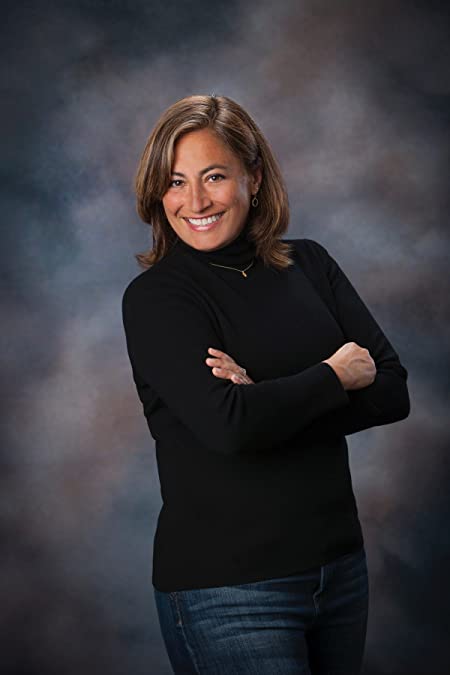
About the Author
Beth Ferry loves to wander, explore and mainly laze on the shore, but only in the summer. She is the author of several picture books, including Stick and Stone. She lives with her husband and three children by the beach in New Jersey.
For more information, visit https://www.bethferry.com/.
Thank you for listening to the Growing Readers Podcast episode: Beth Ferry Discusses Stick and Stone: Best Friends Forever. For the latest episodes from The Growing Readers Podcast, Follow Now on Spotify. For similar books and articles, you can check out all of our content tagged with Beth Ferry, Family, Friendship, Tom Lichtenheld, and Unconditional Love.

